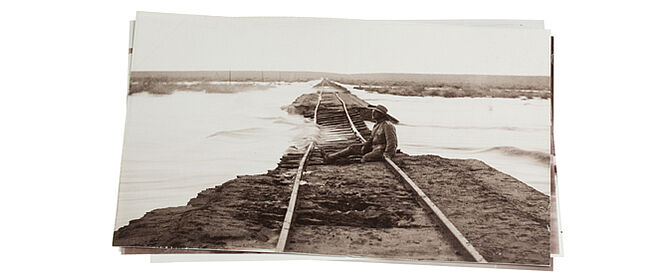WASHED-OUT RAILWAY EMBANKMENT BETWEEN KEETMANSHOOP AND LÜDERITZ
German South West Africa (present day Namibia), around 1910

The exhibition
In the exhibition ‘German Colonialism. Fragments Past and Present’, featuring more than 500 exhibits, the Deutsches Historisches Museum addresses various aspects of German colonialism for the first time. Although the German Empire was one of the major European colonial powers from 1884 until the end of the First World War, it is only in the past few years that the colonial past has increasingly begun to enter public consciousness in Germany. The exhibition offers fascinating insight into the interests, development and dynamics of German colonial history and tells of the scope of action within which a broad spectrum of German, African and Oceanian players pursued their aims and motives. The multifarious power relations in the colonies ranged from local alliances and the daily exercise of violence to the colonial war in Namibia, which culminated in genocide.
Washed-out railway embarkment between Keetmanshoop and Lüderitz
The embankment at Feldschuhhorn was built by colonial Germany between 1906 and 1907 for the railway line that would connect Keetmanshoop, in the south of the German South West Africa colony, with the port at Lüderitz. Railways played a special role in the infrastructural penetration of the colonies. Their advocates invoked the construction of railway routes as a symbol of progress, while critics rejected it as utopian. This photograph, taken just a few years after the embankment was built, shows a soldier of the ‘protection force’ (Schutztruppe) crouching on the washed-out tracks in a pose that is anything but heroic. What the picture does not show is the history of the railway line’s construction, which is directly linked to the genocide against the Herero and Nama people. This swiftly built section of the line was intended to enable the direct supply of provisions to the German colonial troops, and in the long term to secure military domination of the colony’s southern parts. For the construction work, prisoners of war were brought in from the concentration camp on Shark Island, Lüderitz. Statistics collected by the German colonial administration show that of the 2014 prisoners put to work between January 1906 and June 1907, 1359 died during the construction.